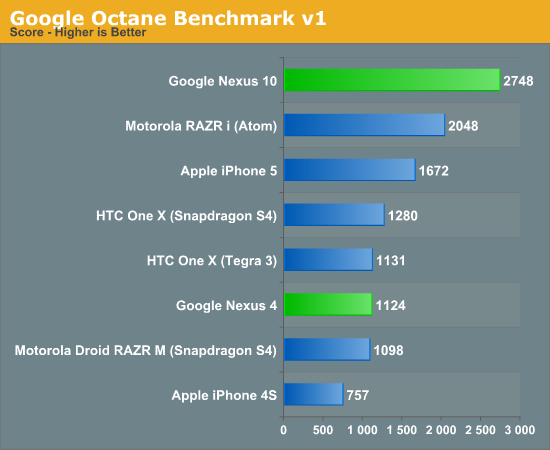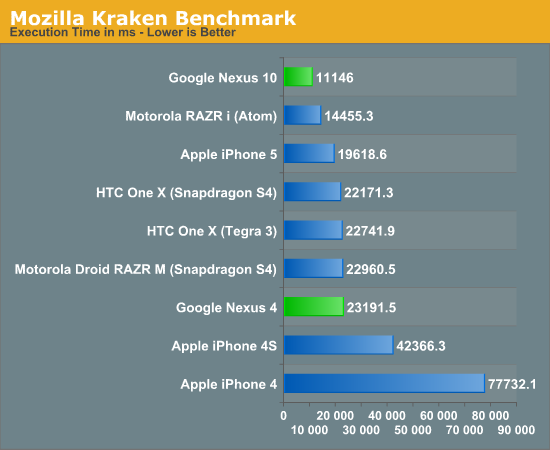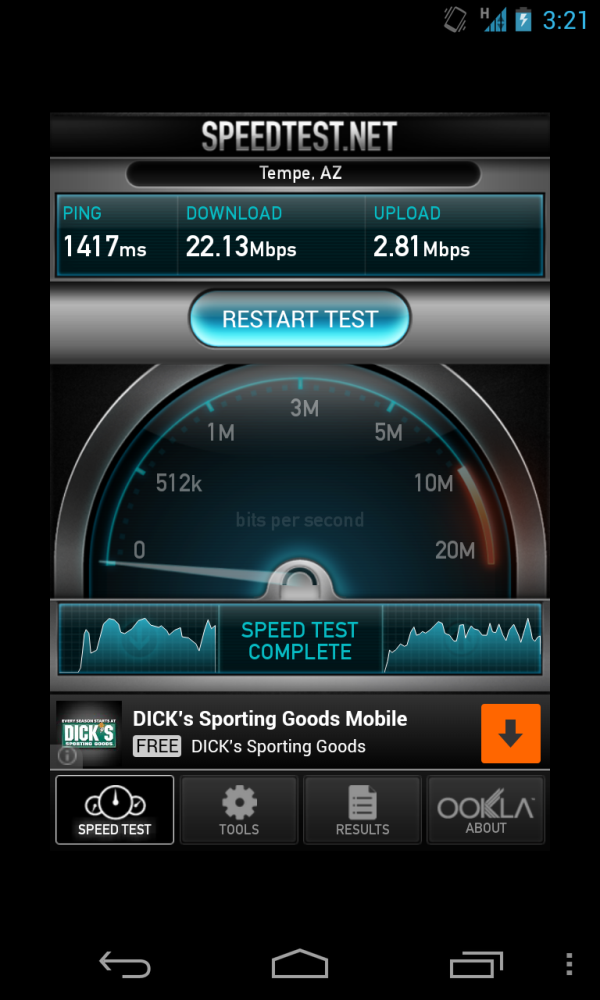Google Nexus 4 and Nexus 10 Performance Preview
by Anand Lal Shimpi & Brian Klug on November 2, 2012 11:00 AM ESTEarlier this week Google announced two new flagship Nexus devices: the Nexus 4 smartphone and the Nexus 10 tablet. We received review samples of both earlier this week, and while we're hard at work at full reviews of the devices we couldn't help but share all of the test data we've been able to amass at this point.
For those who aren't familiar with it, the Nexus 4 features Qualcomm's Snapdragon S4 Pro SoC - a quad-core 28nm Krait CPU with Qualcomm's next-generation Adreno 320 GPU. The combination proved quite formidable in the MDP/T we tested, as well as LG's recently announced Optimus G. The SoC drives a 4.7-inch 1280 x 768 IPS display and is paired with 2GB of LPDDR2 memory. The Nexus 4 ships unlocked with 8GB of NAND for $299 without a contract ($349 for the 16GB version). Pair that with DC-HSPA+ support and you get an absolute killer smartphone for use on T-Mobile: no contracts, very low monthly fees, and compelling cellular performance:
Brian will talk more about the combination in his full review, but rest assured that the lack of LTE is workable depending on T-Mobile coverage where you live/travel to.
The Nexus 10 also boasts a brand new SoC: Samsung's Exynos 5 Dual. The Exynos 5 Dual features two ARM Cortex A15 cores running at 1.7GHz as well as ARM's own Mali-T604 GPU. This happens to be the exact same platform used in the new Chromebook, just running Android. The Nexus 10 features a 10.1-inch 2560 x 1600 display, giving it the same resolution as the 13-inch MacBook Pro with Retina Display - but in an even smaller form factor. Google is also aggressive on Nexus 10 pricing: the 16GB WiFi-only tablet sells for $399, with the 32GB version going for $499.
Both Nexus devices run Android 4.2 and are guaranteed to be the first devices to be updated to upcoming Android revisions for the foreseeable future (it's the power of Nexus).
We haven't had a ton of time to test the devices and put this together so you're going to see combined performance charts throughout the rest of this article.
CPU Performance
The big story when it comes to CPU performance is a look at how the Cortex A15s perform under Android. Unfortunately we're still left with mostly browser based benchmarks to measure CPU performance, which actually highlights a major issue in our testing: Android V8 optimization doesn't seem to be anywhere near as good as it is under Chrome OS or Windows. As a result, all of the Nexus 10 performance scores end up slower than the new Chromebook - despite using the same SoC and running Chrome on both platforms. It's also possible that the Exynos 5 Dual in the Chromebook is allowed to burn a bit more power, translating to better performance, but either way the solution here in the Nexus 10 doesn't look as good across the board.

SunSpider performance is good, but not significantly better than Qualcomm's Krait based Snapdragon S4. Both the iPhone 5 and RAZR i are able to outperform the Nexus 10. The S4 Pro based Nexus 4 tends to be in line with other S4 based devices - SunSpider doesn't really give much credit to the extra 2 cores.

BrowserMark puts the Nexus 10 behind many platforms that should be faster, I'm even wondering here if there's some hard partitioning of memory bandwidth between the CPU and GPU to drive the 2560 x 1600 display that's simply choking the CPU here.
The Nexus 4 does ok, but again there seem to be some V8 optimization issues at work here under Android 4.2. At 1.5GHz it should deliver at least the performance of the dual-core Snapdragon S4 solutions.

Octane is the first test where the Cortex A15s are really able to flex their muscle - the Exynos 5 Dual based Nexus 10 manages to outperform the RAZR i by 34%, and compared to the A6/Swift based iPhone 5 the advantage grows to 64%.
The Nexus 4 performs about in line with other Snapdragon S4 based devices, although once again the extra 2 cores don't seem to be doing much for it here at all.

Kraken also paints the Cortex A15 based Nexus 10 in a good light: there's a 30% advantage over the RAZR i and a 76% advantage over the iPhone 5. These numbers will shrink a bit compared to other tablets, but not by much. The Nexus 4, once again, ends up performing similarly to dual-core Snapdragon S4 based devices.
Overall, the Nexus 10 results show us some real promise for what we can expect from ARM Cortex A15 based SoCs. The potential upside to this new architecture is huge.

















244 Comments
View All Comments
doobydoo - Wednesday, November 7, 2012 - link
'So just because Apple claimed a 2x performanceincrease, we should have blindly believed them?
Finally you show your bias...
(as for me, NOW THAT I'VE SEEN TESTS of the iPad 4, I have no problem calling it King of the Hill of GPU performance).'
Given that the iPad 3 and iPhone 5 already beat this Nexus 10 in most of these benchmarks, it would only have taken a 10% bump for the iPad 4 to dominate. Apple claimed 2x and has a track record of providing accurate estimates. Thus you'd have to be illogical and biased to claim any other outcome. That is obvious, and clear. And yes, you're right, the iPad 4 absolutely destroys the Nexus 4 and 10.
'Says who?
On what are you basing such claims?'
Um, your whole point was how bad Quadrant scores are and how irrelevant they are, and your exact original claims depend on the accuracy of GL benchmarks. So you're criticising the very thing your point depends on.
'NO, if you knew how one of such tests was implemented, or had any idea of how to write one, you'd know that such synthetic benchmarks stress ONE SINGLE aspect in isolation, creating totally unrealistic conditions.'
I never said they didn't. I'm a 3D game designer, and I myself have written numerous benchmarks. If YOU had a clue, you would know that the individual aspects being broken down IS valuable because depending on the complexity and features of the scene being rendered, those different aspects are tested to different extents. It's clearly the combination of the entire pipeline which leads to the end result, but there's a reason your suggestion involves multiple games - they don't all require the same performance in all aspects. That's why you selecting the only benchmark the Nexus 10 beats a phone, is ridiculous. Especially given that there's another benchmark which uses the full pipeline and which it comfortably loses on.
'Open any PC graphic card review on Anandtech or reputable competing sites.
And yes FPS is not the only measure of perfomance, but since you cannot change quality settings on mobile phone games, the quality argument doesn't hold candle here.'
You completely missed the point. I was asking you to show me the FPS results. Of all the games. The whole point is that there AREN'T ANY, so we can't use that benchmark, so the GL benchmark range is the best we have. The fact that you can't change the graphics settings is irrelevant. If your phone performance being poor means you can't play games at as high quality, you're losing out as a customer. Even if it plays at a resolution of 1x1 at 6,000 FPS. Such a primitive excuse to say that just because the quality is locked, it doesn't matter. Absurd, in fact. Fanboy excuses all over.
'The Chromebook runs a DIFFERENT OS!
And a different SW stack!
That makes the difference!
But the LG Optimus G and the Google Nexus 4 ARE THE SAME PHONE on the SAME OS!
With the difference of phone storage size and SD Card slot.
And minor SW customizations.
There is no point about "same architecture", here we're talking about the exact same CPU!'
Nope, sorry, they have very different hardware aspects, the whole heatsink arrangement is fundamentally different. They also only share certain parts in common, not every element.
Final paragraph of yours is just you illustrating that the Nexus 4 being so poorly built that thermal issues come to the fore (exactly as they have done on the better heat-managed Optimus G) is a reason not to buy it.
The fact that even picking the best results for this phone from the most favourable reviews in the most favourable conditions (or even with the most favourable browser), it still loses out by a long way to the iPhone 5, with lower battery life, no LTE, lower storage capacities, glass back, AndroidAuthority articles on its poor build quality, are just making my point more and more.
xaml - Thursday, November 8, 2012 - link
Isn't it ironic that you would rely on some Android Authority article stating some XDA article which, as it seems, is pointless. http://www.reddit.com/r/Android/comments/12m8zc/ne...chippey5 - Wednesday, November 28, 2012 - link
Thanks pipper, we need more people like youmayankleoboy1 - Friday, November 2, 2012 - link
Just a stupid question : will a super fast memory card improve the battery life , compared to standard/cheap memory cards , compared to internal NAND.A5 - Friday, November 2, 2012 - link
I've never seen an SD card that's faster than internal NAND, so I really doubt it.mayankleoboy1 - Friday, November 2, 2012 - link
So how about faster MMC and a slower MMC ?Aenean144 - Friday, November 2, 2012 - link
It's doubtful. SSDs don't seem to improve battery life over HDDs that much, so that's a clue there.The dominant power consumers are 1) the display, 2) the radios (with cellular consuming more than WiFi), and 3) the SoC. Everything else is will be in the noise. You can theoretically take power consumption of the storage to zero, and it'll be in the noise of the said big 3 players.
rd_nest - Friday, November 2, 2012 - link
ARM says that the T604 @ 500MHz has a 2Gpixel/s fill rate. I believe the T604 in Exynos 5 is clocked at 533MHz.Why explains such a big difference in fill rate?
makken - Friday, November 2, 2012 - link
Wow, first glance the performance and battery life of the Nexus 4 seems disappointing compared to the iPhone 5. I was expecting something at least competitive.UpSpin - Friday, November 2, 2012 - link
Me too.I think the performance issues are software related, but battery life isn't really great, but hopefully can be improved with a software update, too.